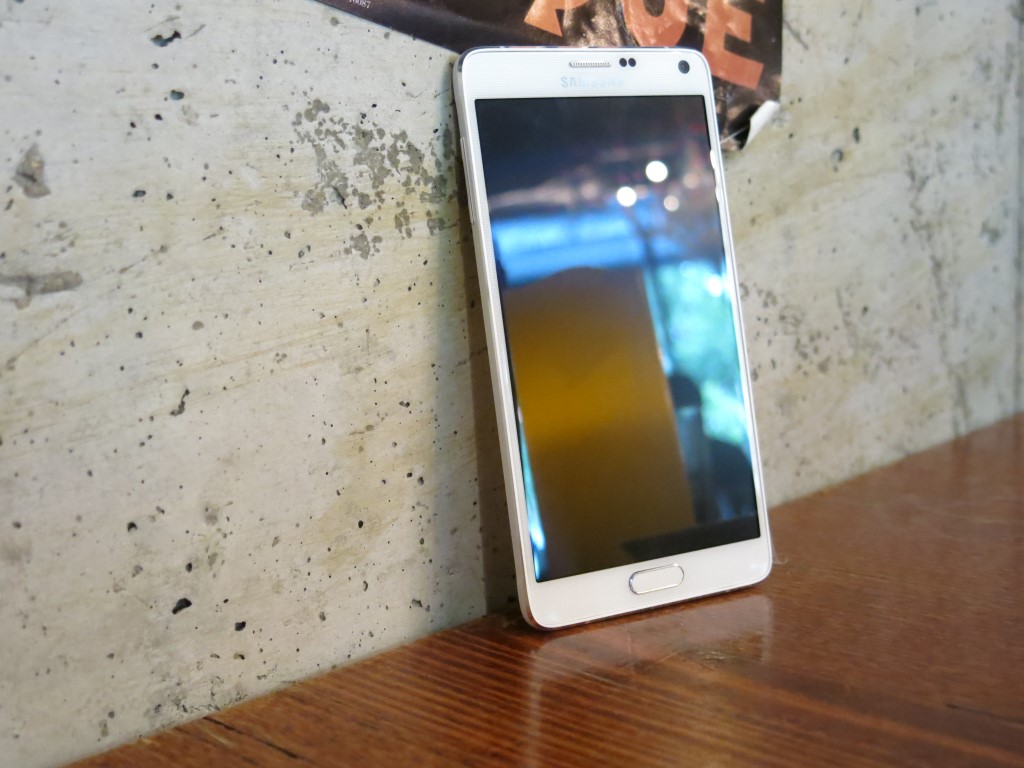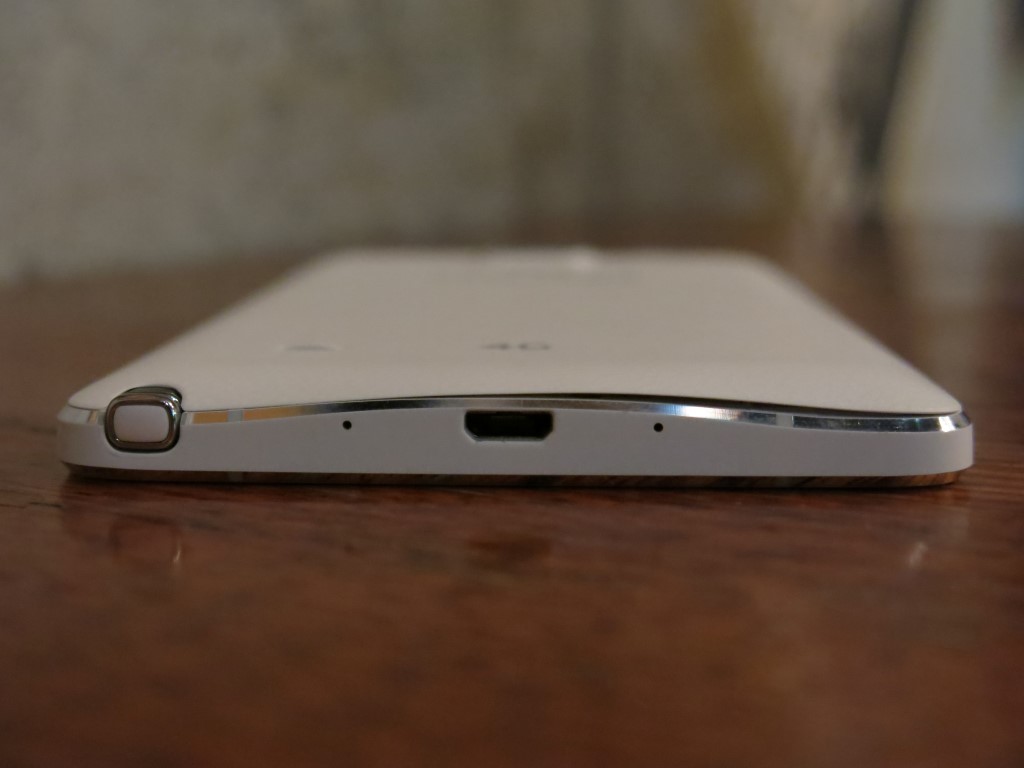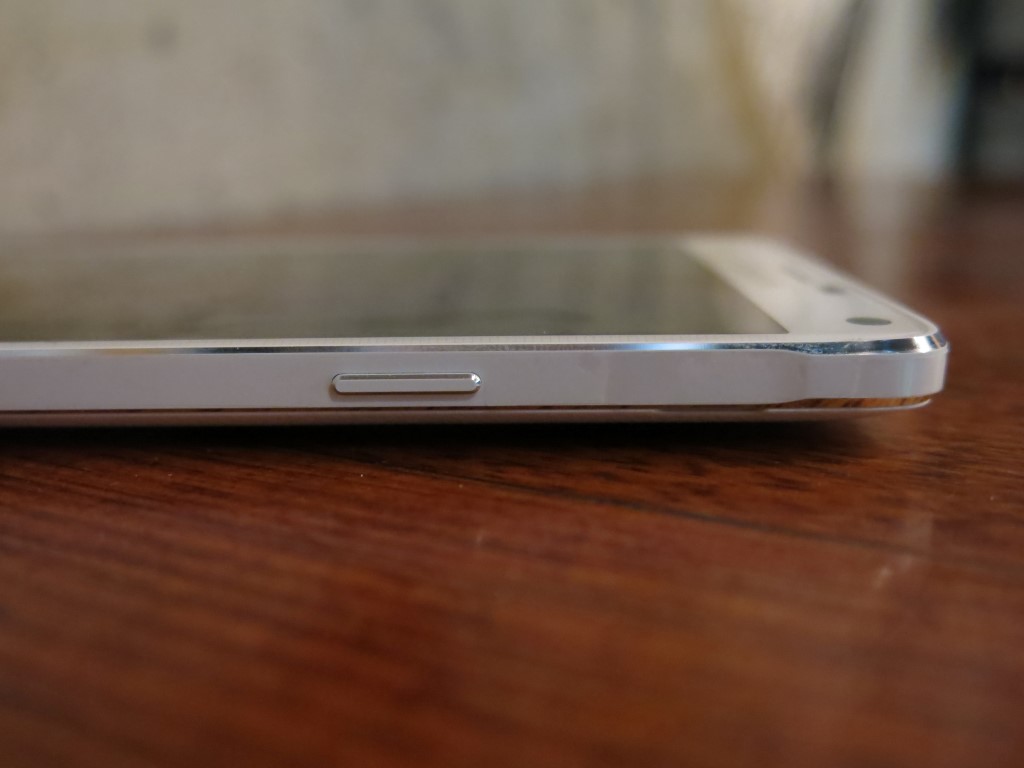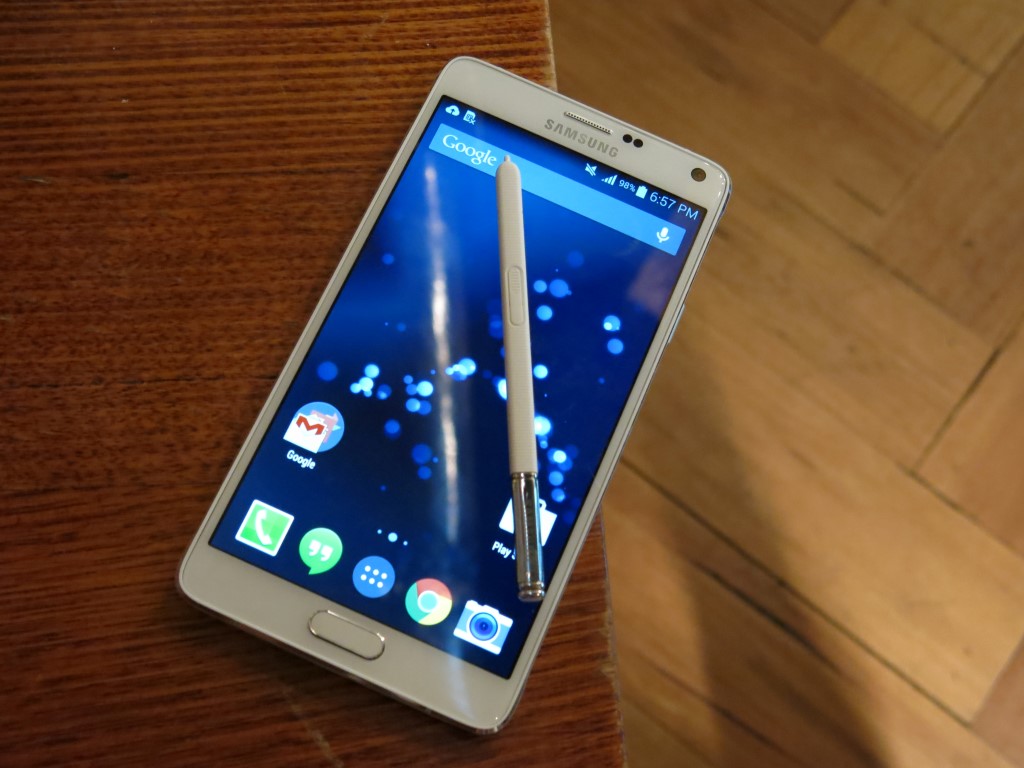
There was a time when a Samsung Galaxy Note was the only viable option for someone who wanted a large phone. Then the market started to shift, screens became larger and 5” is now the norm – even the guys who said “no one’s going to buy a big phone” are making a big phone.
How does the Note 4 fare against the competition? At a time when there are many choices at the big end of the market, is the Note 4 worth your dollars or that 2 year commitment? How does it compare to the previous Notes?
- S-pen can be difficult to remove
- Fingerprint scanner can be unreliable
- Larger than the average phone
Hardware
It wasn’t all that long ago I owned a Note II, but it hadn’t taken me long to forget how big, bulky and heavy the Note is compared to my current phone the Nexus 5. On the other hand, I quickly became re-accustomed to the large bright screen and the fantastic battery life the Note offers. Advances had been made in the design with the Note 4 sporting a larger screen and battery into a phone that is relatively the same size as the Note II was, but much more attractive.

The review unit is the ‘Frosted White’ with chrome accents, a sleek and attractive phone. It is only just manageable with one hand, but you are seriously tempting fate if you do this on a regular basis – I dropped it twice (thankfully onto carpet). The power button is well placed on the right hand side conveniently within thumb reach, and the volume rocker at the upper left which aligns well with the middle finger. The headphone jack is on the top of the phone on the left hand side and the IR blaster on the right. On the bottom of the phone is the microUSB port in the centre, Samsung this time opting for a micro USB2 rather than the large and ugly Micro USB3 on the Note 3. On the bottom right is the s-pen which sits snugly and requires a finger nail to remove.

On the front face of the phone is the large home button at the bottom centre which doubles as a fingerprint reader. On the right hand side of the home button is a backlit capacitive back button, and a backlit multiwindow/multitask capacitive button on the left. Pressing the home button or the power button will wake the device.
The rear is plastic but with a faux-leather texture which makes it easy to grip and reduces your chances of dropping it. The 16MP camera lens protrudes from the centre at the top and the phone will rest on the lens when it is placed on a flat surface.

Screen
The screen is large, vibrant and very bright. If you’ve used Samsung phones before you’re probably used to it, if you’ve come from another brand then it may take a while to get used to the brightness and contrast ratio. It looks great, but is right in your face for the first few days. It is a 5.7” Super AMOLED screen with 1440×2560 pixels, more pixels than most people’s living room TV. This is the first time I’ve seen Samsung get the DPI setting right – on previous phones the icons and menus were too large considering the high resolution and large screen, but on the Note 4 I feel they’ve got it right the first time to make use of all that screen real estate.

As a comparison, the iPhone 6 Plus has a slightly smaller screen at 5.5” but also a lower resolution at 1920×1080. The lower resolution means, everything being equal, it will fit less of your webpage on the screen. Another comparison is the Nexus 6 which has a slightly larger screen at 5.96” and the same resolution, although that larger screen also results in a wider and taller phone.
Screen technology does come down to personal preference, but if you like bright vibrant colours then you will love the Note 4 screen; and if you don’t you can always dial it down a bit in the screen settings.
Battery life
Battery life is excellent, as you would expect from a phone with a massive 3220 mAh battery. It is further enhanced by Samsung’s ‘Power Saving Mode’ and ‘Ultra Power Saving Mode’ either or both of which can be engaged to eek even more life when you’re down into the single digits and nowhere near a charger. You will be prompted to enable power saving mode once the battery hits 10%, or you can engage it earlier via the quick access shortcuts in notification pull-down. Within Power saving mode is the option to restrict background data via the mobile network, and you can also ‘restrict performance’ which will disable vibration, reduce CPU performance, reduce brightness and turn off the GPS.
If you expect to be away from the charger for an extended period but need to stay connected, Ultra Power Saving mode will take it to the next level by taking advantage of the super AMOLED screen and utilising greyscale. A super AMOLED screen produces black by switching off the diode, so a greyscale display is taking full advantage of the technology. Samsung claims that the note will last about 1.5 days on 10% battery using Ultra Power Saving mode which is quite impressive. Once you do find a charger, the Fast Charging feature will add about 10% every 10 minutes when plugged into the mains.
Connectivity
The Australian Note 4 is the SM-910G supporting all of the 3G and 4G bands used locally, so no need to worry about hopping between networks. Reception is good, I didn’t find it any better or worse than the Nexus 5. One of the standout features for me is the IR (infrared) blaster, allowing you to use the Note 4 to control your TV or other audio visual equipment directly from the phone. Using the included Smart Remote app I was switching on my Samsung TV and changing channels on my Foxtel box within minutes. Most popular brands and models are catered for and are very easy to set up. Useful when you don’t have your TV remote in easy reach, or you’re in a waiting room somewhere and want to change the channel.
Performance
The Note 4 released in Australia has the Qualcomm Snapdragon 805 CPU which is a quad-core 2.7 GHz Krait 450 with the Adreno 420 GPU and 3GB of RAM – plenty powerful enough for anything you can throw at it. Despite all this power I did notice the very occasional stutter or pause when scrolling through homescreens or webpages, it’s not a major issue and is sadly present on most android devices anyway.
There is 32GB storage on board with a microSD slot for cards up to an additional 128GB, very handy if you prefer to store your music locally rather than stream it, or if you want to take a lot of photos.
The home button on the Note doubles as a fingerprint scanner, allowing you to set a fingerprint scan as security to unlock your phone. This is a good security measure considering how much personal information we store on our phones, and is much more convenient than remembering a security PIN or pattern. The fingerprint scanner works by firstly pressing the home button to wake the phone, then sliding your thumb down the home button so it can read your print. Not as good as the iPhone which reads your print while pressing the home button, and I found it to be slightly less accurate also, but still a good feature and one I used to secure the phone.
Camera
The rear camera on the Note is a 16MP with optical image stabilisation, capable of 30 frames per second at 2160p or 60 frames per second at 1080p. The front camera is 3.7MP which is great quality for what is effectively a selfie camera for most people.
The camera can be accessed directly from the home screen and is ready to take a photo quickly, which is important because you need to be able to capture the moment not miss it waiting for the camera to load. The camera app is easy to use with a number of modes and filters such as selective focus, panorama and HDR. It even has a rear-cam selfie mode, where it will vibrate or beep when your face is lined up so you can take that perfect 16MP selfie.
Overall performed OK in well lit and low light situations, however I found the colours oversaturated in some photos and low light photos could be better – check out the gallery for some examples.
Software
The Note 4 ships with Android 4.4.4 Kit Kat, Samsung have promised an upgrade to Android 5.0 Lollipop in ‘early 2015’. Samsung have made a number of modifications to stock android via their TouchWiz overlay, many of them improvements. Below are just a few of the more interesting additions:
- Download booster – Use 4G and wifi simultaneously to download files over 30MB
- Easy Mode – For those who find Android’s numerous options and settings overwhelming, easy mode will change the home screen and settings to show the bare minimum functional apps, such as browser, phone, contacts and messaging.
- Blocking mode – Disable all notifications or enable only those whitelisted between certain hours
- Power saving – Disable features to conserve battery when below a certain percentage, or when you know you won’t be near a charger for an extended period
- Multiwindow – True multitasking with two apps run in split screen
- S Health – A suite of fitness related apps where you phone will count your steps, measure your heart rate, track your diet and calories burned
S-Pen
A major differentiating feature of the Note 4 is the s-pen, a stylus which slots into the bottom right corner of the phone. This is no ordinary stylus, nothing like the rubber tipped pens you may have used on a tablet or other phones, instead this is a dedicated digitiser which can detect very fine movement on the screen or up to 12mm away.

The pen itself has a rectangular profile, unlike the round shape in previous Notes. The plastic is textured enabling a secure grip and there is a single button where your thumb rests when holding in a standard pen position. The s pen can be used instead of your finger and also works on the capacitive backlit Back and Multitask buttons.

When the s pen is removed an Air Command menu pops up giving you direct access to the most commonly used functions – Action Memo, Smart Select, Image Clip and Screen Write. I found myself using the s pen for the first few days but rarely used it thereafter. People who like to sketch, take screen grabs, prefer writing over typing or touching up photos would find it a lot more useful.
Samsung Galaxy Note 4 (SM-N910G) Specifications:
- 5.7″ Quad HD+ Super AMOLED (2560 x 1440)
- 2.7 GHz Quad-Core Snapdragon 805 Processor
- 3GB RAM
- 32GB Internal memory (around 24GB usable) + microSD slot (up to 64GB
- Cameras
- Rear Facing: 16 Mega pixel Auto Focus camera with Smart OIS
- Front Facing: 3.7 Mega pixel camera with f1.9
- WiFi 802.11 a/b/g/n/ac (HT80) MIMO PCIe, GPS/GLONASS/Beidou, NFC, Bluetooth® v 4.1 (BLE, ANT+), IR LED (Remote Control), USB2.0, MHL 3.0
- Radios:
- 2.5G (GSM/ GPRS/ EDGE): 850/900/1800/1900 MHz
- 3G (HSPA+ 42Mbps): 850/900/1900/2100 MHz
- 4G (LTE Cat 4 150/50Mbps) or 4G(LTE Cat 6 300/50Mbps): B1(2100), B2(1900), B3(1800), B4(AWS), B5(850), B7(2600), B8(900), B28(700)
- Gesture, Accelerometer, Geo-magnetic, Gyroscope, RGB, IR-LED, Proximity, Barometer, Hall Sensor,Finger Scanner, UV, Heart Rate Monitoring, SpO
- S-Pen Stylus
- Android 4.4 (KitKat)
- 3,220 mAh Li-ion battery, Fast Charging (Adaptive Fast Charging & QC2.0)
- 153.5×78.6×8.5mm @ 176grams
PC Mark Benchmarks
Work Performance: 3,901
Battery Life: 5 h 34 min
View at Futuremark.com.
The Galaxy Note 4 has a large high resolution screen, long battery life, some useful software enhancements, and of course the S-pen which all combine to produce a really great phone. Now that larger phones are a lot more common you won’t get any funny looks when you pull the Note 4 out of your pocket, in fact you may even get accused of owning an iPhone 6 Plus which has very similar dimensions.
Even though phones are getting larger and screen sizes approaching 6” are no longer unusual, I still recommend heading to your nearest retailer to spend some time with the phone before purchasing to ensure you can handle the size and weight. The fourth version of the Galaxy Note has been refined, and a lot of the issues present in previous versions have been addressed such as the textured back to reduce the risk of dropping, a better shaped S-pen, and a higher resolution screen.
You can pick one up on contract from Telstra for $77 per month (only 500MB data), $86 per month on Vodafone (4GB data), $62 per month on Optus (only 500MB data), $57 per month on Virgin (only 300MB data) or $859.95 outright at Yatango for the N910U Exynos version.












